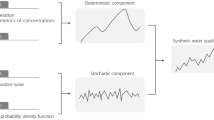Abstract
Data records with equidistant time intervals are fundamental prerequisites for the development of water quality simulation models. Usually long-term water quality data time series contain missing data or data with different sampling intervals. In such cases “artificial” data have to be added to obtain records based on a regular time grid. Generally, this can be done by interpolation, approximation or filtering of data sets. In contrast to approximation by an analytical function, interpolation methods estimate missing data by means of measured concentration values. In this paper, methods of interpolation and approximation are applied to long-term water quality data sets with daily sampling intervals. Using such data for the water temperature and phosphate phosphorus in some shallow lakes, it was possible to identify the process of phosphate remobilisation from sediment.








Similar content being viewed by others
References
Einax JW, Zwanziger HW, Geiß S (1997) Chemometrics in environmental analysis. VCH, Weinheim
Thomann RV (1967) In: Proceedings of ASCE. J San Eng Div 93:1–23
Edwards AMC, Thornes JB (1973) Water Resour Res 9:1286–1295
Reckhow EH, Chapra SC (1983) Engineering approaches for lake management, vol 1. Data analysis and empirical modeling. Butterworth, Woburn, UK
Van Dongen G, Geuens L (1998) Water Res 32:691–700
Worral F, Burt TP (1999) J Hydrol 214:74–90
Hirsch RM, Slack JR, Smith RA (1982) Water Resour Res 18:107–121
Van Belle G, Hughes JP (1984) Water Resour Res 20:127–136
Franses PH (1994) J Econometrics 63:133–151
Hondzo M, Stefan HG (1996) Water Res 30:2835–2852
Bhangu I, Whitfield PH (1997) Water Res 31:2187–2194
Young PC, Whitehead PG (1975) A recursive approach to time-series analysis for multivariable systems. In: Vansteenkiste GC (ed) Modelling and simulation of water resources systems. North-Holland, Amsterdam, pp 39–52
Whitehead PG (1978) 12:377–384
Beck MB (1979) Applications of system identification and parameter estimation in water quality modelling. IIASA, WP-79–99, Laxenburg
Vecchia AV (1985) Water Resour Bull 21:721–730
Whigham PA, Recknagel F (2001) Ecol Model 146:275–287
Straškraba M, Gnauck A (1985) Freshwater ecosystems—modelling and simulation. Elsevier, Amsterdam
Beck MB (1978) Mathematical modelling of water quality. IIASA, CP-78–10, Laxenburg
Gnauck A (2000) Fundamentals of ecosystem theory from general systems analysis. In: Jørgensen SE, Müller F (eds) Handbook of ecosystem theories and management. Lewis, Dordrecht
Danzer K, Hobert H, Fischbacher C, Jagemann K-U (2001) Chemometrik. Springer, Berlin Heidelberg New York
Little RJA, Rubin DB (1987) Statistical analysis with missing data. Wiley, Chichester, UK
Latini G, Passerini G (eds) (2004) Handling missing data. WIT, Southampton, UK
Keith LH (1988) (ed) Principles of environmental sampling. ACS, Washington
Sanders TG, Adrian DD (1978) Water Resour Res 14 569–576
Dandy GC, Moore SF (1979) In: Proceedings of ASCE. J Environ Eng Div 105:695–712
Casey D, Nemetz PN, Uyeno DH (1983) Water Resour Res 19:1107–1110
Lange H (1999) Charakterisierung ökosystemarer Zeitreihen mit nichtlinearen Methoden. Bayreuther Forum Ökologie, Bd. 70, Bayreuth
Meloun M, Militky J, Forina M (1994) Chemometrics for analytical chemistry. Ellis Horwood, New York
Hilborn R, Mangel M (1997) The ecological detective. Princeton University Press, Princeton, NJ
Adorf H-M (1995) Interpolation of irregularly sampled data series— a survey. In: Shaw RA, Payne HE, Hayes JJE (eds) Astronomical data analysis software and systems IV. Academic, New York, pp 1–4
Pagano M (1978) Ann Stat 6:1310–1317
Young PC (1984) Recursive estimation and time series analysis. Springer, Berlin Heidelberg New York
Hornik K, Stinchcombe M, White, H (1989) Neural Networks 2:359–366
Vecchia AV, Ballerini R (1991) Biometrika 78:18–32
Franses PH, Draisma G (1997) J Econometrics 81:273–280
Franses AV (1999) Periodicity and structural breaks in environmetric time series. In: Mahendrarajah S, Jakeman AJ, McAleer M (eds) Modelling change in integrated economic and environmental systems. Wiley, New York
Young PC (1999) Prog Environ Sci 1:3–48
Romanowicz R, Petersen W (2003) Acta Hydrochim Hydrobiol 31:319–333
Gnauck A, Winkler W (1983) Acta Hydrochim Hydrobiol 11:109–124
Costanza R (1991) (ed) Ecological economics. Columbia University Press, New York
Baltagi BH (1999) Econometrics. Springer, Berlin Heidelberg New York
Box GEP, Jenkins GM, Reinsel GC (1994) Time series analysis. Prentice Hall, Englewood Cliffs, NJ
Helmer R (1981) Nat Res XVII:7–13
Taniguchi M, Kakizawa Y (2000) Asymptotic theory of statistical inference for time series. Springer, Berlin Heidelberg New York
Lijklema L (1980) Environ Sci Technol 14: 537–541
Lijklema L (1983) Water Supply 1:35–42
Schettler G (1993) Dynamik und Bilanz des Schadstoffaustauschs zwischen Sediment und Wasserkörper in umweltbelasteten Havelseen. DFG, Bonn
Furrer G, Wehrli B (1993) Appl Geochem Suppl 2:117–119
Mothes G (1982) Acta Hydrophys 27:218–224
Schettler G (1995) Die Sedimente der Havelseen und deren jahreszeitliche Dynamik. In: Landesumweltamt Brandenburg (Hrsg.): Die Havel. Studien- und Tagungsberichte Bd. 8, Potsdam, pp 46–57
Mallat S (1997) A wavelet tour of signal processing. Academic, New York
Gnauck A, Tesche T (1998) Int Rev Hydrobiol 83:207–214
Acknowledgements
The author is indebted to Bernhard Luther and Hartmut Nemitz for their technical help, and to Thomas Tesche for wavelet computations.
Author information
Authors and Affiliations
Corresponding author
Rights and permissions
About this article
Cite this article
Gnauck, A. Interpolation and approximation of water quality time series and process identification. Anal Bioanal Chem 380, 484–492 (2004). https://doi.org/10.1007/s00216-004-2799-3
Received:
Revised:
Accepted:
Published:
Issue Date:
DOI: https://doi.org/10.1007/s00216-004-2799-3




